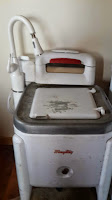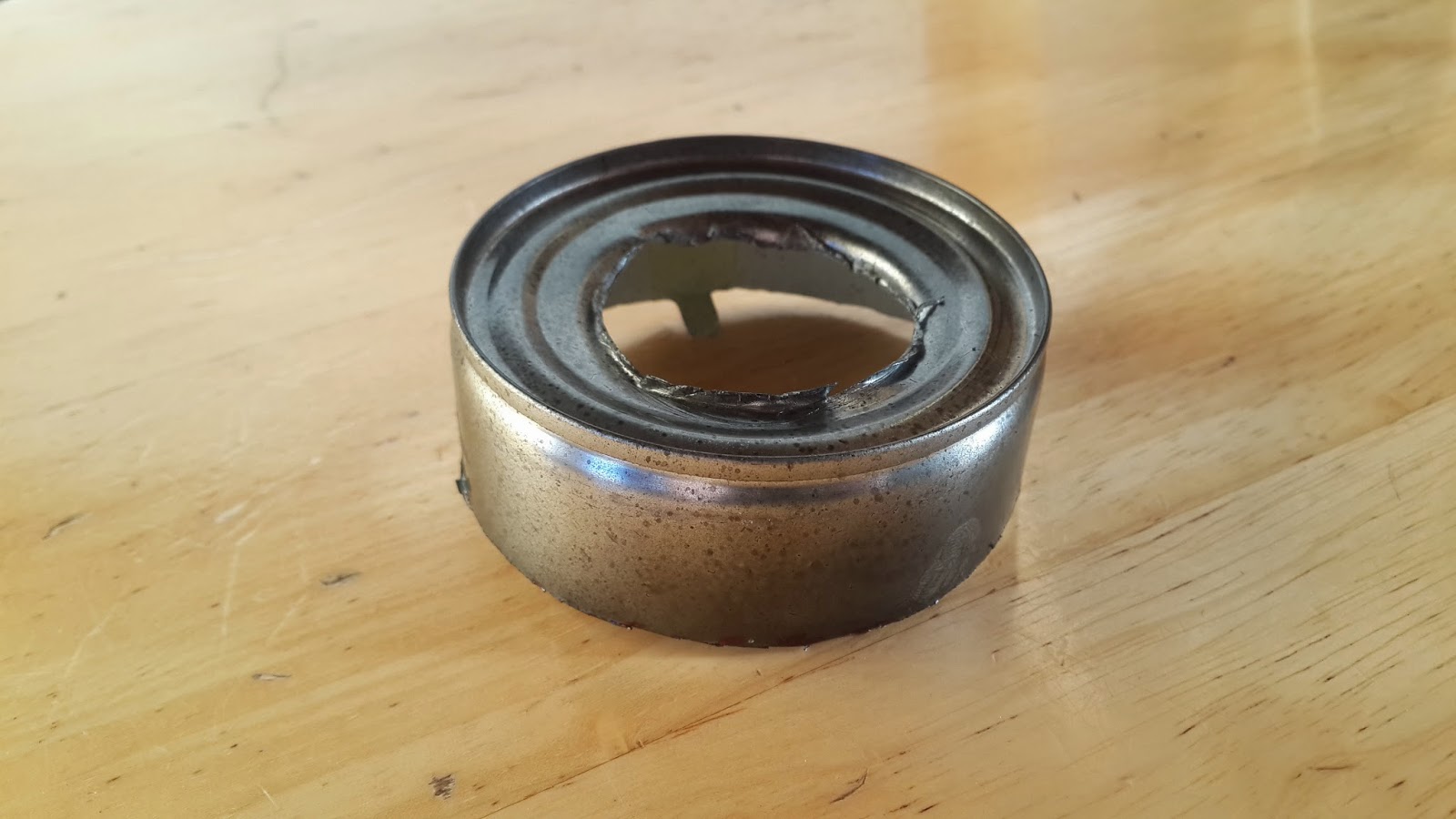
A few years back I started collecting some old rusty lanterns, a few that had probably been my grandpa's. I loved the look of them and I confess I felt a little nostalgia for my childhood days when we had our cattle drives or camp outs. On the cattle drives we used an old wood cookstove to cook meals in an antiquated sheep camp and used a couple of old coal oil lanterns for lighting. The warmth and illumination of the firelight always felt comforting if not magical to me. I was determined to use the old lanterns I had collected in my home somehow, if nothing else, for decor, but, after a few trips to the hardware store, a few new ideas took shape. I was sure I could preserve the lanterns, and their antique value, in their entirety while using the lanterns as light fixtures in my home. Without any cutting, drilling or damage to the lanterns, I found a way to convert them to electric light fixtures and electric lamps.

On this post I will focus on just lamp making because it has virtually the same steps as the fixtures (and I'm needing to build another lamp right now for my mantle as I robbed the old one to go beside my bed; Darn those mystery novels). So if you have some old lanterns and you'd like to make light fixtures or lamps out of them, here's how I did it.


1st I wanted my lanterns in as good a condition as possible and most of them were in pretty bad shape. If you want them rusty and antiqued without their glass globes, handles, etc., then skip this step. If not, this is what I did. Most of my lanterns were rusted solid. To get the rust off and down to whats left of the original paint/patina, pour a regular size bottle of molasses from the grocery store in a 5 gallon bucket of water and place the lantern in the mixture for a day or two, then scrub gently with a pink Brillo pad and rinse. Yes, it has to be a Brillo pad, not steel wool or anything abrasive. It was freezing outside when I was soaking my lanterns so I put the bucket of brown goo in the shower and shut the door where it would be out of the way of my kids' little curious fingers and if any dribbled out on accident while I was checking a lantern it would be easy to clean up. I forgot to tell my husband about my project and he got quite a start when he stepped into the shower with the brown sludge bucket. (Not to worry, he healed up nicely.) Most experts will tell you to soak them for only a few days but I actually forgot two of my really rusted lanterns that were soaking in the molasses mixture for a week (this was after I moved the bucket out of the shower to a new, kid-secluded location-so secluded even I didn't notice them apparently). I don't know if it damaged them, but I know it sure cleaned them up nicely! I didn't need the Brillo pad at all and I could see a few traces of the original paint colors as well. After they had been rinsed and dried off I wanted to prevent any further rusting and I like my metal to shine so I sprayed a few coats of clear spray lacquer on my lanterns. (If you are worried about devaluing your lanterns through the cleaning or restoring phase or are worried about using clear lacquer, hit the internet sites, like lanternnet.com about preserving and cleaning old lanterns. That's where I learned about the
molasses bath and Brillo pads.)

After cleaning them up, I wanted to learn enough about my lanterns to order replacement parts like the glass globes that most of them were missing. There are some great websites out there to help identify your lantern. Make sure you look all over your lantern for any lettering or numbers as that can make the job much easier. I found a helpful site, once again it was lanternnet.com, that helped me identify my lanterns and find everything I needed to fix them. Even if the company that made your lantern no longer exists (as was the case with one or two of mine) there is usually a way to find a part that will work. I would also like to mention here that if you want to fix the lanterns so that they can be used for their original purpose as coal oil, kerosene or whatever kind of fuel-burning lantern, these websites can help
you there too.
2nd After I replaced the parts I needed, it was time to get my electrical supplies. I needed a socket, some lamp cord, a switch, a couple of small wire nuts to secure the wire connections from the lamp cord to my socket and for this type of lantern, a can of green chiles (just because that size of can fit the dimensions I needed...and I knew how to cook a favorite family dish with the chiles).


3rd I removed the part of the lantern that holds and adjusts the wick and flame size. (I can't remember its technical name and I'm willing to bet most of you don't know or care either.) Because I didn't want to cut or damage the lantern, I needed to remove this piece. I have kept all of these pieces and put them in a safe place so that if I want to restore the lamp to its oil-burning glory, I can. In the meantime I needed a piece that I could manipulate and cut to fit an electrical lightbulb socket. (If you cannot bear to use a common tin can, hit a big box store and buy a cheap lantern similar to your antique, if you can find one, then strip the part and cut it up. I used a can. It worked great, was cheap and the chicken tortilla soup I made with the green chiles was delicious.) Next, If you are gifted with tin snips, you can poke a hole in the center of the empty chile can and cut a nice circle just large enough to fit the socket. I am not gifted with tin snips so I measured my socket and used a drill that diameter. It can get tricky with a drill so go slowly and I'd recommend wearing protective eye wear and gloves. After I had the hole drilled and made sure my socket piece would fit, it was time to cut the sides of my can so that it fit the lantern correctly. (Not all lanterns are the same so make sure you have your can measured and cut correctly to fit. If you have the glass globe installed in your lantern or the original glass is still there, remove it carefully until you get the can fitted properly and everything wired.) Once I made sure that my can fit into place correctly, I removed it. This is the time to paint, antique or lacquer this piece, if you like, so that it looks as natural and camoflauged there as possible.
4th I secured the socket to the can and mapped a way to hook up my lamp cord. For all of the lanterns I encountered, there was a pretty easy way to run the cord so that I never had to drill or cut anything. For my lamps I usually open the fuel cap and run the cord into the empty fuel area and up through the lantern where the wick would go. For other fixtures I've run cord up the tubing on the sides and out the venting areas in the top. For this particular lamp, the cord went in the
fuel cap opening and up through the center where I split the cord (about 3 inches back from the end of the lamp cord) and stripped off the plastic coating on the lamp cord about 1/2" on each side. For my first projects i used a pocket knife. Electrical wiring pliers are so much handier but not necessary if you don't have 'em) I then connected the cord to my handy socket by holding both wire ends together, ends pointing to the ceiling, and twisting the wires together in a clockwise direction and securing and covering them with the two small wire nuts. If you twist the wires in a clockwise direction then the wire nuts will actually tighten and improve the wire connection as you twist them on, if not the wire nuts may weaken the connection and "un-twist" your wires. (On lamp cord if you look closely you will see that one of the sides of the cord is smooth while one is ribbed. The smooth side is usually the hot or black wire and connects with the black, while the ribbed connects with the white or neutral wire.) This done, I pushed the wire nuts and extra lamp cord into the base of the lantern and fastened the can holding the socket into place.

5th put a bulb in the socket, replace the glass globe on your lantern and plug it in. You've got yourself an antique lantern lamp!
(I will try to include pics of some of my other lantern light fixtures and if there is any interest I may do another post.)



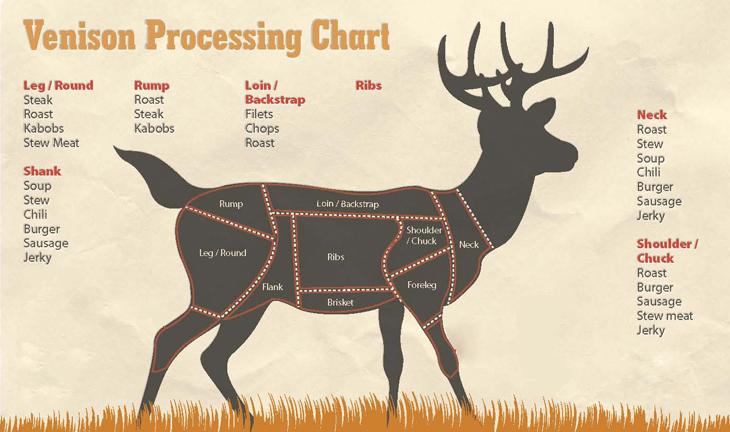







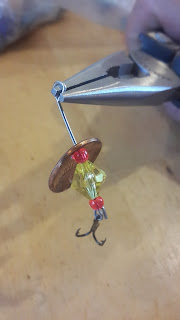





























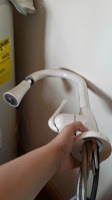


 8th I secured the pipe to the antique washer using 2 very large and very cheap plumbing pipe clamps.
8th I secured the pipe to the antique washer using 2 very large and very cheap plumbing pipe clamps.
